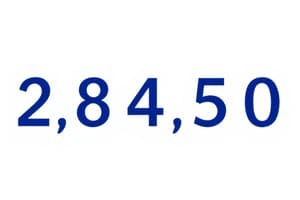Podcast
Questions and Answers
Which of the following numbers is a rational number?
Which of the following numbers is a rational number?
- 0.01001000100001... (correct)
- 3.141592654...
- 1.4142135...
- 214.121122111222...
What type of number is the value of Pi (π)?
What type of number is the value of Pi (π)?
- Irrational (correct)
- Whole number
- Rational
- Recurring decimal
How does the text prove that 2 is an irrational number?
How does the text prove that 2 is an irrational number?
- By dividing 2 by a prime number
- By showing that 2 is a whole number
- By taking the square root of 2
- By squaring both sides of the equation 2 = p/q (correct)
In the proof that 2 is irrational, what does the text assume about p/q?
In the proof that 2 is irrational, what does the text assume about p/q?
What would happen if 3 was assumed to be rational?
What would happen if 3 was assumed to be rational?
What type of decimal is 0.142857142857... according to the text?
What type of decimal is 0.142857142857... according to the text?
What is the defining characteristic of a rational number?
What is the defining characteristic of a rational number?
Which of the following is an example of a terminating decimal?
Which of the following is an example of a terminating decimal?
What type of decimal can always be converted into a common fraction?
What type of decimal can always be converted into a common fraction?
Which of the following is a characteristic of irrational numbers?
Which of the following is a characteristic of irrational numbers?
What is the defining characteristic of a recurring decimal?
What is the defining characteristic of a recurring decimal?
Why do non-terminating, non-recurring decimals represent irrational numbers?
Why do non-terminating, non-recurring decimals represent irrational numbers?
Flashcards are hidden until you start studying
Study Notes
Rational Numbers
- A rational number can be expressed as a fraction of two integers, where the denominator is not zero.
- Examples of rational numbers include fractions like 1/2 and whole numbers like 3.
Value of Pi (π)
- Pi (π) is classified as an irrational number because it cannot be expressed as a simple fraction.
Proving 2 as an Irrational Number
- The proof of 2 being irrational typically utilizes contradiction, demonstrating that if 2 were rational, it would lead to an impossible situation.
Assumptions in Proof
- In proofs, p/q is often assumed to represent the simplest form of a rational number expression of 2.
Assuming 3 as Rational
- If 3 were incorrectly assumed to be rational, it could lead to contradictions similar to those found in proofs regarding other irrational numbers.
Characteristics of 0.142857142857…
- The decimal 0.142857142857… is a recurring decimal as it repeats the sequence "142857" indefinitely.
Defining Characteristics of Rational Numbers
- The defining characteristic is the ability to be expressed as a fraction, hence exhibiting a finite or repeating decimal form.
Example of a Terminating Decimal
- An example of a terminating decimal is 0.75, which has a finite number of digits after the decimal point.
Converting Decimals into Fractions
- Any decimal that terminates or is recurring can be converted into a common fraction.
Characteristics of Irrational Numbers
- Irrational numbers cannot be expressed as fractions; they may represent non-recurring, non-terminating decimals.
Defining Characteristic of a Recurring Decimal
- A recurring decimal has a digit or group of digits that repeat infinitely after the decimal point, like 0.666...
Non-Terminating, Non-Recurring Decimals
- Such decimals represent irrational numbers because they cannot be precisely expressed as fractions and do not exhibit repeating patterns.
Studying That Suits You
Use AI to generate personalized quizzes and flashcards to suit your learning preferences.




